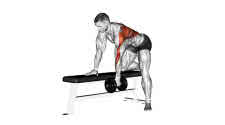Understanding One-Arm Dumbbell Rows: Stretch-Position Exercise for Midback

There's Science to Exercise Techniques
The one-arm dumbbell row is a stretch-position exercise for the mid back. While it may appear that you get peak contraction at the top
of the range of motion, most trainees don't achieve complete contraction due to torso roll. As you pull up, your torso rolls away from
the dumbbell, which prevents peak contraction in your mid back.
Two-arm mid back movements performed with your arms slightly wider than shoulder width are best for hitting the midback's contracted
position; for example, bent-arm bent-over laterals. This exercise allows you to squeeze your scapulae together at the top of the range
of motion, which is a prerequisite for mid back contraction. Although your hands do come together at the bottom of bent-arm bent-over
laterals, achieving the complete stretch position for the mid- back, because you're much weaker in the contracted position, you're forced
to use a weight that you can take to the top, and that weight is going to be too light to force activation of the myotatic reflex. In
addition, you should keep a constant bend at your elbows throughout the movement, which also prevents you from reaching the stretch
position. So you now have one-arm dumb-bell rows for hitting the stretch position and bent-arm bent-over laterals for the contracted
position.
As for mid back midrange movements, you should be pulling from overhead to hit this position, and your arms should travel slightly back to
get some scapulae movement. Behind-the-neck pulldowns fit those specifications. With this exercise you get synergy from your biceps and
lats, and if you concentrate on a scapulae squeeze at the bottom, you'll really feel every rep in your mid back.
The behind-the-neck pulldowns involve synergy from your biceps and lats and give your mid back a thorough heavy-weight hit. Then the one-arm
dumbbell rows allow you to activate the myotatic reflex and prime your mid back for maximum fiber recruitment. The bent- arm bent-over laterals
let you squeeze your mid back in the contracted position so you can fire the reserve muscle fibers that were called into action during the
dumbbell rows. This is a very efficient and effective routine for building mid- back thickness.
Here are a few more observations concerning the one-arm dumbbell row:
Your working arm should travel straight up and down, not down and forward. This vertical pulling helps keep the mid back muscles engaged. Many so-called experts say to let the dumbbell travel forward as you lower it in order to stretch the lats, but remember, you're not working your lats, you're working your mid back.Speaking of lats, don't keep your arms close to your sides during one-arm dumbbell rows, or you'll force your lats to be the prime movers, as they are in undergrip barbell rows. Your upper arm should angle away from your torso as you pull the dumbbell up. This focuses the stress on the mid-back.